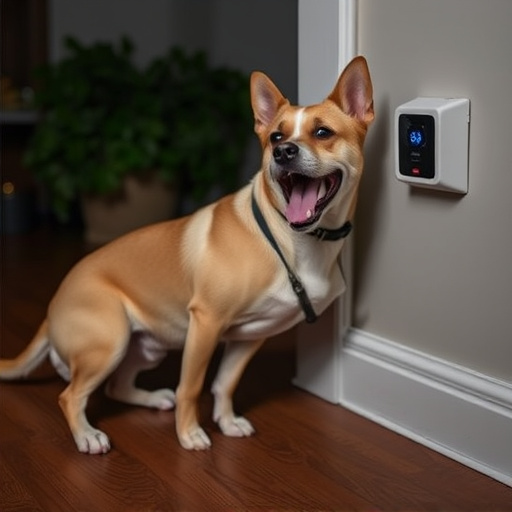Electronic barking dog alarms offer a cutting-edge security solution, combining advanced sensors and AI algorithms to mimic multiple dog barks for intrusion detection. These devices minimize false triggers, provide remote monitoring via smartphone apps, and offer customizable sensitivity levels. Installation involves strategic sensor placement and maintenance ensures optimal performance. Training pets to respond calmly enhances their effectiveness in deterring burglars while alerting homeowners.
“Unleash a powerful home security tool with an Electronic Barking Dog Alarm – a innovative solution for deterring intruders. This comprehensive guide, ‘Understanding Electronic Barking Dog Alarms,’ takes you on a journey through the technology, benefits, and intricacies of these devices. From how they work to types and installation tips, we demystify these alarms. Discover their advantages in home security, learn about key features, and explore why this could be your dog-free, yet effective, line of defense against potential threats.”
Understanding Electronic Barking Dog Alarms: A Comprehensive Overview
Electronic barking dog alarms are innovative security solutions designed to protect your home and property from potential intruders. Unlike traditional dog alarms, these modern devices use electronic sensors and advanced technology to detect and respond to unwanted trespassers. By mimicking the protective behavior of a dog, they emit loud, startling barks when triggered, effectively deterring burglars and alerting homeowners to potential threats.
These alarms are equipped with sensitive motion detectors and sound-activated features, ensuring they only activate in response to actual threats. They can be easily installed around your property, creating a virtual perimeter that triggers an audible warning when breached. Additionally, many electronic barking dog alarms offer remote monitoring and control options, allowing you to manage your security system from anywhere using your smartphone or tablet. This comprehensive overview highlights the key features, benefits, and working principles of these advanced security devices, emphasizing their role as reliable guardians for your home and family.
How They Work: The Technology Behind the Alarm
Electronic barking dog alarms utilize advanced technology to protect your home and deter potential intruders. At the heart of these devices is a sophisticated sensor system that detects movement, vibration, or changes in sound waves. When an intruder triggers the alarm’s sensors, a powerful electronic bark is emitted, mimicking the distress call of a dog. This unexpected auditory cue can startle and alert homeowners or neighbors, providing valuable time to respond.
The technology behind these alarms often includes motion sensors, such as passive infrared (PIR) sensors, which detect heat signatures, and vibration sensors that recognize sudden movements. Some models even incorporate advanced AI algorithms to differentiate between animals, pets, and humans, ensuring false alarms are minimized. The alarm can be controlled remotely via a smartphone app, allowing users to arm, disarm, or trigger the bark on demand.
Benefits and Advantages for Home Security
An electronic barking dog alarm offers numerous benefits and advantages for home security, making it a smart investment for homeowners seeking enhanced safety. Unlike traditional alarms that rely on sensitive pressure mats or motion detectors, this innovative device leverages the power of sound to deter intruders. When triggered by movement, the alarm simulates the barks of multiple dogs, creating an intimidating and unpredictable noise that can startle and scare off potential thieves.
The effectiveness of this method lies in its ability to provide a strong psychological deterrent. Even if an intruder manages to bypass other security measures, the sudden, harsh barking sounds can create chaos and confusion, giving homeowners valuable time to respond or alert authorities. Moreover, electronic barking dog alarms are often designed with adjustable sensitivity levels, allowing users to customize the settings according to their specific needs and preferences. This adaptability ensures that the alarm responds only when necessary, minimizing false alerts and ensuring peace of mind for the entire family.
Types and Features to Consider Before Purchase
When considering an electronic barking dog alarm, it’s crucial to explore the diverse types and features available to ensure a solution that best fits your needs. These alarms offer a range of functionalities, from simulating bark sounds to advanced motion sensors, designed to deter intruders effectively.
Look for options like adjustable sensitivity settings, allowing you to customize the alarm’s response to potential threats. Some models also incorporate LED lights or strobe effects for enhanced visibility during nighttime intrusions. Additionally, consider wireless connectivity and mobile app compatibility for remote monitoring and control, a feature particularly appealing for modern homeowners seeking convenience and peace of mind.
Installation, Maintenance, and Training Tips
The installation process for an electronic barking dog alarm is relatively straightforward and can be done in a few simple steps. Begin by selecting the ideal location for the sensor, typically near entry points or areas where unwanted visitors might approach your property. Ensure it’s securely mounted outdoors, focusing on visibility to deter potential intruders. Connect the sensor to the control panel using provided wires, ensuring all components are powered and properly wired. Test the system immediately after installation to verify its functionality.
Regular maintenance is key to keeping your electronic barking dog alarm in top condition. Check the battery levels regularly and replace them as needed. Clean the sensors periodically to ensure they’re free from debris or dirt, which could hinder their sensitivity. Stay updated with firmware upgrades provided by the manufacturer, as these improvements can enhance the alarm’s performance and reliability. Consistent training is equally vital, especially for new installations. Teach your pets to respond to the alarm’s triggers, reinforcing positive behavior when they remain calm upon activation. This training process ensures that the alarm functions effectively in deterring unwanted visitors without unnecessary false alerts from your furry companions.
